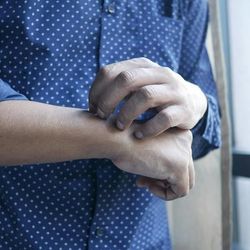
OR WAIT null SECS
Higher Fertility Rates Observed in Male Patients with Rheumatic Disease
Among all groups, fewer men with rheumatic disease were childless compared with controls.
Patients with rheumatoid arthritis (RA), psoriatic arthritis (PsA), and spondyloarthritis (SpA) have a higher number of children per man and are less likely to be childless compared with a cohort of controls from the general population, according to data from a large, nationwide cohort study presented at the 2024 European Congress of Rheumatology (EULAR).1 Additionally, investigators note male fertility is not affected by inflammatory joint diseases (IJD) and factors linked to IDJ appear to improve fertility or the motivation and possibility to have children.
“In the last couple of years, there has been increased awareness regarding possible effects of chronic inflammatory joint diseases (IJDs) on male fertility,” wrote a team of investigators led by Gudrun David Sigmo, PhD candidate at Stavanger University Hospital, Department of Rheumatology, Stavanger, Norway. “The iFAME-fertility study from The Netherlands in 2021 suggested an association between IJDs and reduced fertility. However, a recent extensive cohort study showed that the proportion of childless men was lower in 11,000 Norwegian IJD patients than in matched controls.”
To determine the number of children fathered by men with rheumatic disease as well as the proportion of childless men with RA, PsA, and SpA compared with the proportion of children and childless men among diagnostic groups and between various patient groups and controls, investigators enrolled male patients aged 25 to 65 years old with PsA (n = 2649), RA (n = 1716), and SpA (n = 2766) from the Norwegian Arthritis Registry. These patients were individually matched 1:5 regarding birth year and country of residence to men without IJDs, with the use of data from the National Population Register (n = 35,655).
The birth data were obtained from the Medical Birth Registry of Norway. Investigators compared the mean number of children per man as well as the proportion of childless men with RA, PsA, and SpA compared with controls in addition to 3 patient groups. After age-adjusted analysis between the 3 diagnoses, a referenced age of 50 years was used.
The mean number of children per man was significantly higher in all 3 diagnostic groups when compared with controls (P <.001). Additionally, among all groups, fewer men with rheumatic disease were childless compared with controls (P <.001).
The age-adjusted number of children was comparative to the 3 patient groups (PsA 1.86, RA 1.82, and SpA 1.77 for a man aged 50 years); however, patents with SpA had a statistically significant and slightly lower mean number of children when compared with patients with PsA (difference: .10; 95% confidence interval [CI]: .03 – .16; P <.001).
Other group differences were not statistically significant. Comparable results were exhibited regarding the proportion of childless men, with 17.1% in PsA, 18.7% in RA, AND 20.8% in SpA reported as childness as age 50 years (P <.001 for PsA vs SpA).
“Further data are needed to improve our understanding of how male fertility is affected by various inflammatory joint diseases,” investigators concluded.
References
- Sigmo GD, Hauge S, Hufthammer KO, Wallenius M, et al. Male Patients with Psoriatic Arthritis, Rheumatoid Arthritis, and Axial Spondyloarthritis Have More Children Than Matched Controls. Presented at: EULAR. Vienna, Austria. June 12 – 15, 2024.
Related Content:


